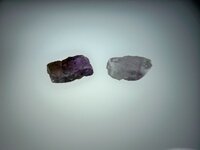StoneWhisper
Hero Member
For morte then 8 years I've been telling minerals and rock collectors of the ahrmfull effects to using salt on the minerals as well as placing the stoens in direct sun light for an extened leinght of time.. These last two years I've been doing an experiments on an Amethyst I've broken and left one in the sun while keeping one in the shard or shadows..
The two years have past and I think it's time to show you what has happen to this once very dark amethyst..
While one braved the sunlight, hot days and cold winters.. the other (darken one) was inside out of harms way. Clearly one can see what happens when one leaves their collector in the sun for to long..
So if you value your collection.. then take care of them by never leaving them in the sun light or cleaning them in a salted solution.
The two years have past and I think it's time to show you what has happen to this once very dark amethyst..
While one braved the sunlight, hot days and cold winters.. the other (darken one) was inside out of harms way. Clearly one can see what happens when one leaves their collector in the sun for to long..
So if you value your collection.. then take care of them by never leaving them in the sun light or cleaning them in a salted solution.






